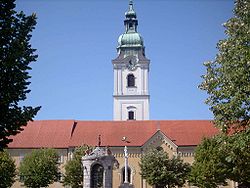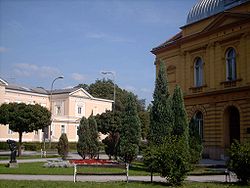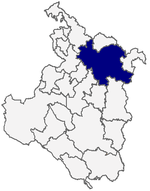- Karlovac
-
Karlovac — Town — Trinity Church (crkva Svetog trojstva) in the center of Karlovac 
SealLocation of Karlovac within Croatia Coordinates: 45°29′N 15°33′E / 45.483°N 15.55°E Country Croatia County Karlovac County Government – Mayor Damir Jelić (HDZ) Area – Town 401 km2 (154.8 sq mi) Elevation 112 m (367 ft) Population (2011) – Town 48,036 – Metro 58,095 Time zone CET (UTC+1) – Summer (DST) CEST (UTC+2) Postal code 47 000 Area code(s) 047 Website karlovac.hr Karlovac (Croatian pronunciation: [kâːrlov̞at͡s]; German: Karlstadt, Carlstadt, Hungarian: Károlyváros) is a city and municipality in central Croatia. The city proper has a population of 49,082, while the municipality has a population of 59,395 inhabitants (2001).
Karlovac is the administrative centre of Karlovac County. The city is located on the Zagreb-Rijeka highway and railway line, 56 km south-west of Zagreb and 130 km from Rijeka.
Contents
History
Karlovac was built from scratch in 1579 in order to strengthen Austria's southern defences against Ottoman encroaches. The establishment of a new city-fortress was a part of the deal between the Protestant nobility of Inner Austria and the archduke Charles II of Austria, in exchange for their religious freedom the nobility agreed to finance the building of a new fortress against the Ottoman Empire. It was founded as a six-pointed star fortress built on the Zrinski estate near the old town of Dubovac at the confluence of the Kupa and Korana rivers. As the city later expanded, the urban area reached as far as the Mrežnica and Dobra rivers. The unique star shape can still be seen around the town. It was originally known as Karlovec, Karlstadt, Carlstadt, or Carlstatt ("Charles's Town" in German), after Archduke Charles II of Austria, upon whose orders construction began on July 13, 1579. The architect of the city was Matija Gambon.
The first church (of the Holy Trinity) was built in the central square in 1580, but all of the city buildings burned down in the fire of 1594. The forces of the Ottoman Empire laid siege to Karlovac seven times, the last time in 1672, but failed to occupy it. The plague epidemic of 1773 was also a notable threat to the city, decimating almost half the population at the time.
As a military outpost of the Habsburg Monarchy, Karlovac was the site of the trial and execution of the best-known leader of the rebel Uskoks from the coastal fort of Senj, Ivan Vlatković. He was executed in Karlovac on 3 July 1612 as an example to his troops who were creating difficulties for the Habsurgs by their piracy against Venetian shipping on the Adriatic Sea, and by marauding raids into the Ottoman hinterland. 1615 their piracy went so far as creating an open war between Venice and Austria. When the Treaty of Madrid was concluded in 1617, bringing an end to the war between Venice and the Habsburgs, under the terms of the treaty the Uskok families were forcibly removed from Senj and disbanded into the hinterland, most notably in the Žumberak hills near Karlovac.
Meanwhile, the fort was becoming too crowded for the city's expanding population and the Military Frontier government could not allow for its further growth. On December 6, 1693 the city received some limited self-government. Queen Maria Theresa, after long insistence from the Croatian Parliament, restored the towns of Karlovac and Rijeka to the Croatian crownland on August 9, 1776. Maria Theresa was also responsible for the founding of Gymnasium Karlovac. King Joseph II reaffirmed it as a free town with an official charter in 1781, allowing the citizens to expand the city and exploit the potential of being at the crossroads of paths from the Pannonian plains to the Adriatic coast. The town blossomed in the 18th and 19th centuries with the development of roads to the seaside and waterways along the Kupa River. After World War II, Yugoslav authorities established the Dubovac internment camp in Karlovac.[1][2][3]
The town's fortunes declined in the 20th century, though it is currently recovering.
Karlovac suffered much damage during the Croatian War of Independence (1991–1995). The southern sections of the city were close to the front lines between the Republic of Croatia and the rebel Serbs, and the neighborhoods of Turanj, Kamensko as well as parts of Mekušje, Mala Švarča and Logorište were devastated by shelling. The city center, the city hall and numerous other buildings were also damaged.
Until the early 2000s, Karlovac's main industry was its beer "Karlovačko", produced by Karlovačka pivovara. In recent years, the rapidly growing firearms manufacturer HS Produkt has become the city's largest private employer. HS Produkt is best known as the designer and manufacturer of the HS2000 pistol, sold in the United States as the Springfield Armory XD.
Description
Croatians know Karlovac as grad parkova (the city of parks) and grad na četiri rijeke (the town on four rivers) for its numerous green areas and four rivers, of which the Mrežnica, the Korana and the Kupa flow through built-up areas, and the Dobra is a few kilometers outside the city centre. A documentary film made by Dušan Vukotić in 1979 on the occasion of the 400th anniversary of the founding of the city plays much on that theme, and shows pictures of happy bathers on the Korana's Fogin beach (Foginovo kupalište) in the city centre.[4]
One of the rarer trees found in the parks is the Ginkgo biloba, which local primary school children are taken out to see as part of their classes on nature and society. Most of the parks are planted in the former trenches dug around the old military fort that were once filled with water as an added layer of protection from the marauding Ottoman armies. One part of the city centre maintains the name of Šanac ('trench') after the old trenches which preserve the old hexagonal form of the historic centre.
Demographics
According to the 2001 census, the Karlovac municipality had a total population of 59,395.
50,997 of its citizens are Croats (85.86%), 5,076 are Serbs (8.55%), 186 are Albanians (0.31%), 149 are Bosniaks (0.52%), 71 are ethnic Macedonians (0.12%), 59 are Montenegrins (0.10%), and the rest are other ethnicities.
Population by religion are 49,197 Roman Catholics (82.83%), 4,414 Orthodox Christians (7.43%), 653 Muslims (1.10%), 93 Byzantine Catholics (0.16%) and others.[5]
Much of the population of Karlovac has changed since the beginning of the 1991-95 Croatian War of Independence, with numerous families of Croatian Serbs leaving and being replaced by people who were themselves displaced from parts of Croatia that were held by rebel Serbs during the war (such as from the town of Slunj), as well as by families of Bosnian Croats who started arriving during the war. The migration outflow was mostly towards Serbia, the Republika Srpska entity in Bosnia and Herzegovina, and to countries of Western Europe, North America and Australia.
Settlements
The list of settlements included in the administrative area of the city of Karlovac includes:[6]
- Banska Selnica, population 90
- Banski Moravci, population 69
- Blatnica Pokupska, population 31
- Brezova Glava, population 130
- Brežani, population 129
- Brođani, population 143
- Cerovac Vukmanićki, population 928
- Donja Trebinja, population 21
- Donje Mekušje, population 207
- Donji Sjeničak, population 69
- Gornja Trebinja, population 169
- Gornje Stative, population 385
- Gornji Sjeničak, population 152
- Goršćaki, population 119
- Husje, population 177
- Ivančići Pokupski, population 12
- Ivanković Selo, population 25
- Ivošević Selo, population 7
- Kablar, population 111
- Karasi, population 50
- Karlovac, population 46,827
- Klipino Brdo, population 14
- Kljaić Brdo, population 18
- Knez Gorica, population 114
- Kobilić Pokupski, population 43
- Konjkovsko, population 6
- Koritinja, population 112
- Ladvenjak, population 387
- Lipje, population 47
- Luka Pokupska, population 373
- Mahićno, population 521
- Manjerovići, population 32
- Okić, population 66
- Popović Brdo, population 244
- Priselci, population 96
- Rečica, population 537
- Ribari, population 109
- Skakavac, population 267
- Slunjska Selnica, population 77
- Slunjski Moravci, population 84
- Šebreki, population 0
- Šišljavić, population 452
- Tušilović, population 672
- Tuškani, population 216
- Udbinja, population 65
- Utinja, population 5
- Vodostaj, population 509
- Vukmanić, population 210
- Vukoder, population 104
- Zadobarje, population 368
- Zagraj, population 63
- Zamršje, population 185
Culture
The city of Karlovac has memorial-sites dedicated to Croatian veterans of the nation's Homeland War and to the veterans of the Croatian Home Guard.[7][8]
Karlovac is home to the NK Mostanje Croatian soccer team.
International relations
See also: List of twin towns and sister cities in CroatiaTwin towns - sister cities
Karlovac is twinned with:
 Alessandria, Italy
Alessandria, Italy Sarajevo, Bosnia and Herzegovina
Sarajevo, Bosnia and Herzegovina Kansas City, Kansas, United States
Kansas City, Kansas, United States Kragujevac, Serbia [9]
Kragujevac, Serbia [9]
Gallery
See also
- List of people from Karlovac
References
Bibliography
- Cresswell, Peterjon; Atkins, Ismay; Dunn, Lily (10 July 2006). Time Out Croatia (First ed.). London, Berkeley & Toronto: Time Out Group Ltd & Ebury Publishing, Random House Ltd. 20 Vauxhall Bridge Road, London SV1V 2SA. ISBN 978-1-904978-70-1. http://books.google.com/books?id=VZweAAAACAAJ. Retrieved 10 March 2010.
Notes
- ^ U KOLONAMA GOLI I BOSI, BEZ HRANE I VODE, Vjesnik
- ^ Za ratne zločine 29 kaznenih prijava
- ^ U centru Karlovca pronađena masovna grobnica
- ^ IMDb: Karlovac (1979)
- ^ "Karlovac ethnic minorities (Census 2001)". http://www.dzs.hr/default_e.htm. Retrieved 2006-07-02.
- ^ Croatian Bureau of Statistics, Census 2011, http://www.dzs.hr/Eng/censuses/census2011/htm/E11_Zup27_1791.html
- ^ Minister Vukelić unveiled memorial-site in front of the Command of the Croatian Ground Army in Karlovac
- ^ UO for building
- ^ "Kragujevac City Partners". © 2008 Information service of Kragujevac City. http://www.kragujevac.rs/en/city_partners.htm. Retrieved 2008-10-27.[dead link]
External links
- Municipal website
- Tourist information - Karlovac
- Tourist information - Karlovac County
- Interactive town map
- Karlovački Tjednik - Local weekly newspaper
Cities and major settlements of Croatia by population 100,000+ 35,000+ 10,000+ Beli Manastir · Belišće · Benkovac · Čakovec · Crikvenica · Đakovo · Daruvar · Duga Resa · Dugo Selo · Garešnica · Gospić · Imotski · Ivanec · Ivanić-Grad · Jastrebarsko · Kastav · Knin · Koprivnica · Krapina · Križevci · Kutina · Labin · Makarska · Metković · Našice · Nova Gradiška · Novi Marof · Novska · Ogulin · Omiš · Opatija · Petrinja · Pleternica · Ploče · Poreč · Požega · Rovinj · Sinj · Slatina · Solin · Sveta Nedelja · Sveti Ivan Zelina · Trogir · Umag · Valpovo · Virovitica · Vrbovec · Vukovar · Zaprešić · ŽupanjaSubdivisions of Karlovac County Cities and towns Municipalities Categories:- Populated places in Karlovac County
- Cities and towns in Croatia
Wikimedia Foundation. 2010.









